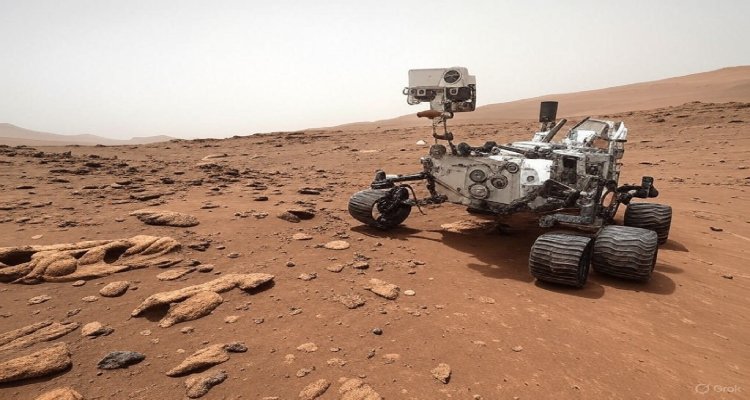NASA’s Curiosity Rover Finds Signs Mars Could Host Life
NASA’s Curiosity rover uncovers ancient Martian carbon, revealing Mars once had the right conditions to support life.
NASA Rover Unearths Proof Mars Was Once Primed for Life
For decades, Mars has held our collective curiosity—its dusty, crimson terrain sparking questions about life beyond Earth. Now, NASA’s Curiosity rover may have just brought us closer to an answer. Buried deep within the Red Planet’s rocky layers, scientists have found compelling evidence that Mars may once have been far more hospitable than we ever imagined.
A Breakthrough Beneath the Surface
In a remote corner of Gale Crater, Curiosity drilled just a few centimeters into the Martian crust and extracted what turned out to be a planetary revelation: siderite, a form of iron carbonate. This mineral, tucked inside sulfate-rich rocks, points to a past atmosphere thick with carbon dioxide—one capable of keeping Mars warm enough to support liquid water.
That’s no small finding. For years, scientists expected to find carbonates formed by interactions between ancient Martian water and atmospheric CO₂. But despite countless missions, those minerals remained elusive. This discovery fills in a crucial gap in Mars’ geological story, and hints that the planet once hosted the chemistry needed for life.
What Siderite Says About Ancient Mars
The rock samples extracted from Mount Sharp date back roughly 3.5 billion years, aligning with the theorized timeline of a planet-wide climate transformation. Known as the “great drying,” this transition marked Mars’ shift from a once-wet world to the arid, frozen desert we know today.
Dr. Benjamin Tutolo, associate professor at the University of Calgary and lead author of the recent study, emphasized the magnitude of this breakthrough. “The discovery of abundant siderite in Gale Crater represents both a surprising and important milestone in our understanding of Mars’ geologic and atmospheric evolution,” he said.
By finding siderite, researchers now have tangible proof that Mars experienced a long-term carbon cycle—one that mirrors processes seen on early Earth.
Carbon: Life’s Essential Ingredient
Carbon isn’t just another element—it’s the foundation of life as we know it. It helps regulate temperature through atmospheric carbon dioxide and serves as a crucial building block for organic molecules.
On Earth, this carbon cycle has been essential to maintaining a habitable climate for billions of years. On Mars, however, the story took a different turn. According to Dr. Tutolo, the precipitation of carbon dioxide into rock, as siderite, may have ended Mars’ warm phase. As the atmosphere thinned and temperatures dropped, the chance for life to flourish likely faded away.
“The broader implications are that the planet was habitable until this time,” he noted. “But then, as the CO₂ that had been warming the planet started to precipitate as siderite, it likely impacted Mars’ ability to stay warm.”
A Planet Frozen in Time—But Not in Secrets
Curiosity’s journey across Mars has spanned over 20 miles since it touched down in 2012. Along the way, it’s uncovered clay minerals, ancient riverbeds, and now, carbonates that hint at a once-dynamic planet. Each drilled sample acts like a geological time capsule, preserving clues from an age when Mars may have resembled early Earth.
NASA scientists believe these findings are not only vital for understanding Mars’ history—but also for learning what keeps planets habitable. Even minor shifts in a planet’s atmosphere can lead to drastic changes over time. Understanding how Mars lost its ability to host water could reveal insights into Earth’s own resilience and vulnerabilities.
The Search for Life Expands
While the discovery doesn’t confirm life once existed on Mars, it undeniably strengthens the case for past habitability. More than just dry dust and red rock, Mars now appears to have once been a planet with potential—complete with warmth, water, and atmospheric dynamics.
This deepens the intrigue around future missions, including potential sample-return initiatives and the upcoming Mars Sample Return campaign, which may finally bring pieces of the Red Planet to Earth for deeper analysis.
Conclusion: Mars Isn’t Just a Dead Planet—It’s a Story in Progress
NASA’s Curiosity rover has rewritten the Martian narrative—what was once thought to be a cold, lifeless planet may have been a cradle for microbial life billions of years ago. With every layer it uncovers, Mars tells us a bit more about its dramatic past—and perhaps a bit more about our own planet’s fate.
As exploration continues, one truth remains: Mars may be frozen in time, but it still has much to teach us about habitability, planetary evolution, and whether we’re truly alone in the universe.
Disclaimer:
This article is based on current scientific findings and interpretations from NASA and academic sources. The presence of ancient carbonates on Mars suggests past habitability but does not confirm the existence of life. Further studies are required for definitive conclusions.
source : The Economic Times











